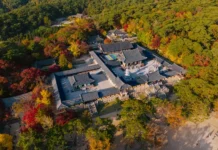 DALLAS: When Don Sanders toured what is now his Kessler Park home in Oak Cliff last year, an inconspicuous slab of concrete partly covered by metal casing caught his eye.
DALLAS: When Don Sanders toured what is now his Kessler Park home in Oak Cliff last year, an inconspicuous slab of concrete partly covered by metal casing caught his eye.
The real estate agent told Sanders it was a storm shelter. But the air vent turbines suggested to Sanders that the original homeowner had prepared for something much more destructive.
Like a nuclear bomb.
Under that metal cover, a steep set of stairs led underground to a cramped fallout shelter furnished with three beds, a toilet and an air and water filtration system, lined with shiny lead. Sanders said he had always wanted to live in Oak Cliff and own a home built in the ’50s, but this slice of history sealed the deal.
“I wanted to buy this house because I like stuff like this,” Sanders, 62, told The Dallas Morning News.
The shelter is the largest of Sanders’ atomic age collectibles, which also include an autographed Elvis record and a fiberglass Big Boy statue. It belongs to an era where doomsday prep was seen as patriotic.
“It wasn’t fringe. It wasn’t marginal. It was mainstream,” said Susan Roy, author of the 2011 book “Bomboozled: How the U.S. Government Misled Itself and Its People Into Believing They Could Survive a Nuclear Attack.”
Sanders, who owns a marketing company, moved from Grapevine and into his home in August 2012. In the year since, he’s adorned it with collectibles from a time period he said he’d choose over any other. Even his red childhood Columbia bicycle hangs on the wall, a testament to his veneration for the bygone era.
But the original homeowner, a dentist, was forward thinking. He installed central air conditioning and a burglar alarm.
The shelter represented a much bigger step in preparedness. Underground, Sanders found a scene that looked to have been untouched for years. A hand crank that filtered air in and out was still in place, as were jugs of brown liquid used to dispel unpleasant smells.
The light switch was elsewhere – the garage – so those entering the shelter could see on their way down.
“The fact that he had the wherewithal to do that, he thought of everything,” Sanders said.
The shelter was built sometime in the early 1960s, Sanders said, during a time when Roy said talk of thermonuclear war got “hot and heavy.” Tensions between the U.S. and Soviet Union escalated during the Berlin Crisis in mid-1961, leading to the construction of the Berlin Wall.
A shelter boom began. A September 1961 issue of Life magazine, with a cover headline promising to teach readers “How You Can Survive Nuclear Fallout,” featured a letter from President John F. Kennedy urging readers to “consider seriously” an ensuing story on shelters.
“It’s human nature,” said Roy, whose book focuses on government and public reaction to the threat of nuclear war. “If you’re threatened with something and someone offers you a way to protect yourself from that threat, you’re probably going to take those actions.”
Cold War tensions and shelter construction peaked with the Cuban missile crisis in 1962. Roy said it’s unclear how many shelters were built – she estimates “tens of thousands to hundreds of thousands” – without detailed records or building permits.
Roy said stories about shelters will pop up, as homeowners make discoveries.
“It’s a weird time capsule from an era that to our eyes now seems simpler,” Roy said. “It represents a time that’s so different from the one we live in. It’s almost like a naive faith.”
Roy said a reasonable cost estimate today would range from $10,000 to $20,000 with inflation, depending on the material used and level of customization.
“All kinds of people got into the shelter-building business, because they saw money to be made,” she said.
Others created their own, like the shelter at Sanders’ next-door neighbor’s home. Warren Farmer, who bought the house from the daughter of the couple who built it, said there’s a seven-foot trench underneath dug by pick and hammer. -AP






